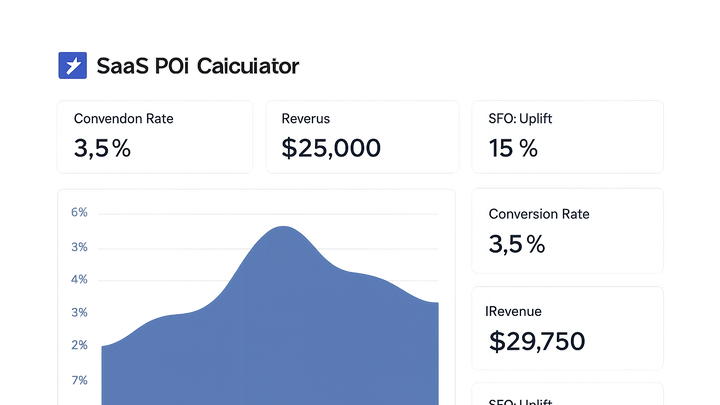Published on 2025-06-29T21:03:22Z
What Is a SaaS ROI Calculator? Examples for CRO/UX/SEO Critiques
A SaaS ROI Calculator is a tool that enables businesses to estimate the financial return of investing in a software-as-a-service platform. In the context of website critiques for conversion rate optimization (CRO), user experience (UX), and search engine optimization (SEO), an ROI calculator quantifies potential gains from recommended changes. By inputting metrics like current conversion rates, average revenue per user, and projected uplifts drawn from actionable critiques (for example, those provided by Prevue.me), you can forecast payback periods and net benefits of optimizations. This empowers teams to prioritize the highest-impact improvements, justify budget allocations, and set realistic expectations. The most effective calculators combine qualitative insights with data-driven projections to drive strategic decision-making and continuous performance tracking.
Saas roi calculator
Tool to forecast returns on SaaS investments by quantifying CRO, UX, and SEO improvements based on actionable critiques.
Understanding SaaS ROI Calculators
An overview of what a SaaS ROI Calculator is, how it works, and why it’s critical for data-driven website optimization.
-
Definition and purpose
A SaaS ROI Calculator estimates the financial return of a SaaS investment by comparing the net gains against total costs.
- Roi formula:
ROI = (Net Gain from Investment − Cost of Investment) / Cost of Investment
- Net gain from investment:
Total benefits generated by the SaaS, such as increased revenue or cost savings.
- Cost of investment:
All expenses related to the SaaS subscription, implementation, and ongoing maintenance.
- Roi formula:
-
Why it matters in cro/ux/seo
Quantifies the value of recommended optimizations, helping teams decide which UX tweaks, SEO fixes, or CRO tests deliver the strongest business case.
Key Metrics and Inputs
The essential data points required to feed into an ROI calculator for accurate, actionable projections.
-
Conversion rate
Percentage of visitors who complete a desired action (e.g., signup, purchase).
-
Average revenue per user (arpu)
Estimated revenue generated by an average user over a defined period.
-
Customer acquisition cost (cac)
Total marketing and sales expenses divided by the number of new customers acquired.
-
Projected uplift from critiques
Estimated improvements in key metrics based on prevue.me’s actionable CRO, UX, SEO, and accessibility critiques.
- Cro uplift:
Projected percentage increase in conversion rate from CRO recommendations.
- Ux enhancement:
Expected reduction in bounce rate or increased session duration from UX improvements.
- Seo impact:
Anticipated uplift in organic traffic and search rankings from SEO optimizations.
- Cro uplift:
Implementing a SaaS ROI Calculator with Prevue.me
Step-by-step guide to integrating prevue.me insights into your ROI calculations for a critique-driven optimization workflow.
-
Collect actionable critiques
Use prevue.me to generate detailed feedback on CRO, UX, SEO, accessibility, and lead generation opportunities.
-
Translate critiques into metrics
Convert qualitative feedback into quantitative estimates for your ROI inputs.
- Assign uplift percentages:
Based on critique severity, estimate realistic percentage improvements for each metric.
- Estimate implementation costs:
Calculate developer hours, design revisions, and any tool expenses required.
- Assign uplift percentages:
-
Run the calculator
Input baseline metrics and projected improvements to compute potential ROI, payback period, and net gain.
Best Practices and Pitfalls
Recommendations to ensure your ROI calculations remain accurate, realistic, and aligned with business goals.
-
Use conservative estimates
Avoid overly optimistic projections; validate assumptions through small-scale A/B tests before full rollout.
-
Regularly update inputs
Keep data current as website performance, user behavior, and SaaS pricing evolve over time.
-
Segment by audience
Calculate ROI separately for different user segments (e.g., free vs. paid, new vs. returning) to uncover tailored opportunities.
-
Document assumptions
Record all underlying assumptions behind your projections for transparency and future audits.
